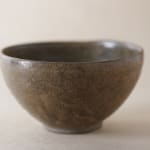


Artisan's Name Unknown
BOWL (KOREAN MID JOSEN DYNASTY), 17TH CENT. MIDDLE JOSEN DYNASTY
3 3/4'' d
Further images
The bowl is an outstanding example of Korean bowls from the 17th century. Its aesthetics inspired the Way of Tea culture in Japan. This way was established by Sen Rikyu;...
The bowl is an outstanding example of Korean bowls from the 17th century. Its aesthetics inspired the Way of Tea culture in Japan. This way was established by Sen Rikyu; his specific way is referenced as the Wabi way of tea. When the Japanese fought with Korea in the 16th century, around the time Rikyu was alive, they found bowls in Korea that possessed an unassuming yet profound beauty. When Sen Rikyu saw the bowls, he was deeply moved by their quiet excellence, which resonated with his vision of Wabi. He searched extensively for a potter who could recognize the inner beauty of the bowls and create bowls that echoed it. Rikyu found such a potter. His name was Chojiro. Now, 400 years later, Rikyu's Wabi way of tea is still the center of the way of tea. Chojiro’s descendants, Raku family are still creating tea bowls.
It is a great pleasure to find a piece of work whose beauty has guided the core essence of Japanese aesthetics.
It is a great pleasure to find a piece of work whose beauty has guided the core essence of Japanese aesthetics.
Signup for our Newsletter
You will receive two emails a month from us. One introduces artworks and design works from Kyoto's hidden sources and the other is stories from Misako, sharing insights into Japanese culture.
* denotes required fields
为了回应您的查询,我们将根据我们的隐私政策处理您提供的个人数据。


